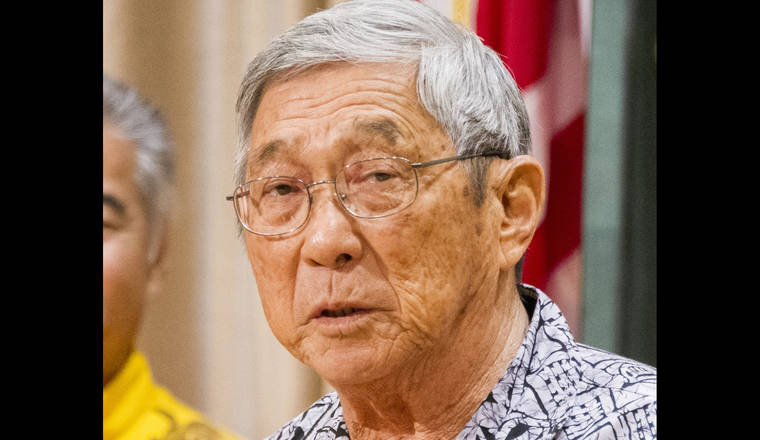Proposed budget would give nonprofits a $1M boost

Mayor Harry Kim
Nonprofit organizations are set to get a $1 million raise in Mayor Harry Kims proposed budget, but County Council members will see their individual contingency accounts shrink from $100,000 to $20,000 each.
Nonprofit organizations are set to get a $1 million raise in Mayor Harry Kim’s proposed budget, but County Council members will see their individual contingency accounts shrink from $100,000 to $20,000 each.
Kim late Friday released a $625.9 million operating budget for the upcoming fiscal year, a 6.9% increase over the current year. The budget relies on an average 3.9% increase, to $343.5 million, in property taxes based on increases in property values, so property owners are likely to see a bigger tax bite, but there are no hikes in taxes or fees contemplated at this point.
ADVERTISING
The preliminary proposed budget now goes to the County Council, which will hold departmental reviews in April. The mayor’s final proposed budget will be released by May 5. Once amended and passed by the council, it goes into effect July 1.
Not all council members are happy with the preliminary spending plan. Kohala Councilman Tim Richards said the budget continues increasing — 35% since he took office in 2016 — but the money isn’t moving to county projects as fast as he’d like.
“What I am concerned about is the fund balance from last year. This is approximately $39 million that we appropriated last year but did not spend,” he said Monday. “Though we have enough funding for our programs going forward, I am concerned we are not being timely with our expenditures. Our community has needs. I look forward to working with the Mayor’s Office to get this situation addressed.”
South Kona/Ka‘u Councilwoman Maile David, who chairs the council’s Finance Committee, raised concerns about the cutback in contingency funds.
“I briefly looked at it Friday after work and did notice the huge reduction in contingency. Twenty thousand dollars per district left me temporarily at a loss for words,” David said. “This greatly impacts our ability to supplement and in some instances provide much needed services in our respective communities, especially those that relate to our kids and seniors.”
The grants-in-aid distributed in a competitive process to nonprofits will increase for the budget year beginning July 1 from $1.5 million to $2.5 million, thanks to a law the council passed last year.
Those grants rely on a formal application and presentation before a council subcommittee, which then makes recommendations to the full council.
But the council contingency accounts, where council members each have their own little pot of money to give in a noncompetitive process after council approval to nonprofits and county agencies that request it, is much smaller.
Kona Councilwoman Rebecca Villegas was also disappointed with the contingency fund cutbacks.
“I’m disappointed to see the amount decreased by so much. However, I’m hopeful that with the collective efforts of the council, we will once again be able increase the allocation of contingency funds per district back to at least $100,000,” she said.
“These monies are extremely helpful in bridging gaps and provides flexibility in allocation of resources directly to projects in our specific districts that so desperately need them.”
The most recent contingency requests as of Monday were for nonprofit groups.
David, for example, is asking approval to give $3,000 to the Hawaii Island Portuguese Chamber of Commerce Cultural and Educational Center for its Malasada Shuffle 5K and Family Fun Festa Radiothon. Another request seeks a $1,500 grant to O Ka‘u Kakou for its 6th Annual Prince Kuhio Day Ho‘olaulea.
Council Chairman Aaron Chung is requesting a $500 grant to the East Hawaii Cultural Council for reimbursement of expenses related to the 2020 Live Aloha Festival.
Richards is asking approval for a $5,000 grant to Kahua Pa‘a Mua Inc., for expenses relating to Project Reach Out, a suicide prevention initiative. He also has a resolution requesting a $4,000 grant to the Island of Hawaii YMCA to provide services to families who need a safe and secure place for child visitations.
Although the most recent contingency grant requests are for money to be given to nonprofits, Chung said the bulk of the contingency funding goes to county government agencies.
Among the contingency relief resolutions at the Feb. 13 council meeting, for example, were three resolutions from David for a total of $6,000 for summer fun programs at the Department of Parks and Recreation, $4,000 for a scoreboard at the Arthur C. Greenwell Park in South Kona and $10,000 to the Department of Public Works for air conditioners and lights at the police substation in Captain Cook.
Chung and Puna Councilwoman Ashley Kierkiewicz raised concerns about how the coronavirus pandemic will affect travel, and therefore revenues, on the island.
“A status quo budget may be good for today, but does it factor in the impacts of something like coronavirus or move us into the direction of a thriving Hawaii Island? Resilience is the philosophy that needs to undergird our budget,” Kierkiewicz said.
“I’m preparing for April budget hearings by diving into the details and doing my due diligence in order to make fiscally responsible decisions.”


